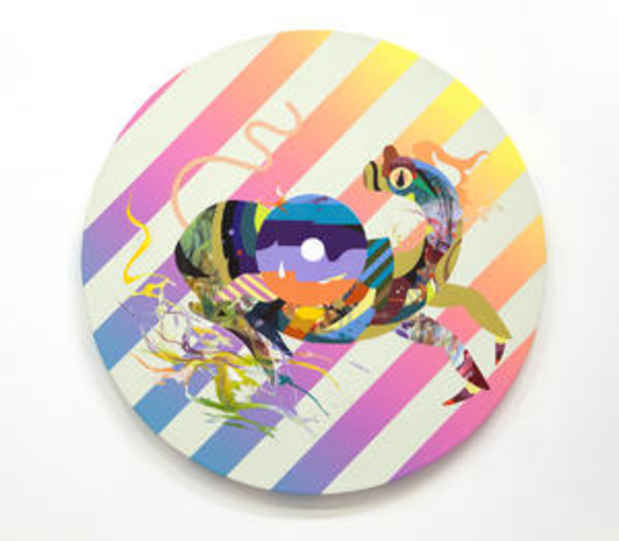Tomokazu Matsuyama "East Weets Mest"
Joshua Liner Gallery

This event has ended.
Joshua Liner Gallery presents East Weets Mest, an exhibition of new paintings, sculpture, and installation by the New York-based Japanese artist Tomokazu Matsuyama. This is the artist’s second solo exhibition at the gallery.
Matsuyama’s wildly colorful art relocates traditional Japanese icons and imagery into a broader international mix of styles, signs, and symbols. The spoonerism of the show’s title, East Weets Mest, playfully mimics this relocation and subsequent homogenization of cultural material, which Matsuyama identifies as a key force in contemporary life. “Urban centers are becoming increasingly familiar, with their patchwork of intermingling cultural signifiers,” says the artist. “This chaotic mix has become the everyday, where traditions and local signifiers dissolve into one another to make a unique new shape of today’s culture.”
In his dynamic acrylic-on-canvas paintings, Matsuyama blends the aesthetics of East and West, appropriating images from art history—the Edo and Meiji eras of traditional Japanese art, in particular—fused with postwar abstract expressionism and contemporary art movements, American animation, and subculture influences such as street art. Mr. Alpha and Mrs. Omega, for example, is an eye-popping tondo diptych featuring a pair of shishi, traditional temple “lion dogs. ” These ancient figures take the form of guardian sculptures at the entrances to shrines, and are found in numerous cultures of the Far East. Signifying the beginning and the end, the eradication of evil, and the ever-expanding cosmos, the temple lion dogs are powerful symbols in Japanese Shintoism, Buddhism, and beyond. Here, Matsuyama’s friendly, Pop-style interpretation of the creatures is abstracted through the use of bright colors and patterned facets, and calls to mind the spirit of works by fellow dog lovers, artists George Rodrigue and William Wegman.
In Toys and Candy, an epic painting measuring 7-x-15 feet, Matsuyama appropriates a classic image of propaganda from the Meiji period—a woodblock from 1894 that depicts Japan defeating its other Asian neighbors. Here, the artist has transformed this nationalist message into a contest among juveniles, their swords beaten not into ploughshares but toys and candy. Awash in whimsical colors, cartoon faces, baseball caps, and popular slogans (“just do it”), the epic work nonetheless harbors disturbing vestiges of the classic print, including an exact likeness of the original composition.
In a further critique of the abuses of power, Matsuyama offers a new sculptural work entitled Money Talks. Here, a traditional Japanese sage/saint, or sennin, is depicted life-size in FRP (fiber-reinforced plastic). But instead of carrying the traditional scroll, a symbol of the saint’s redemption through Buddhist teachings, the artist’s appropriated figure carries a Western-style piggy bank and is accompanied by the figure of a resting deer, a Shinto symbol of salvation. In Matsuyama’s contemporary interplay of East and West, the artist’s relationship to creativity, culture, and commerce is an ongoing question.
[Image: Tomokazu Matsuyama "Yellow Fever" (2011) Acrylic on canvas 30 in. diameter]
Media
Schedule
from September 08, 2011 to October 08, 2011
Opening Reception on 2011-09-08 from 18:00 to 21:00